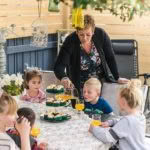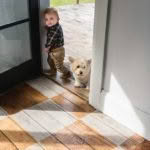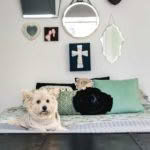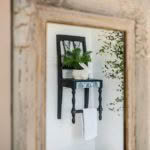From junk to treasure: Foxton’s DIY queen Mel Cowan turns heads with her elegant upcycled creations
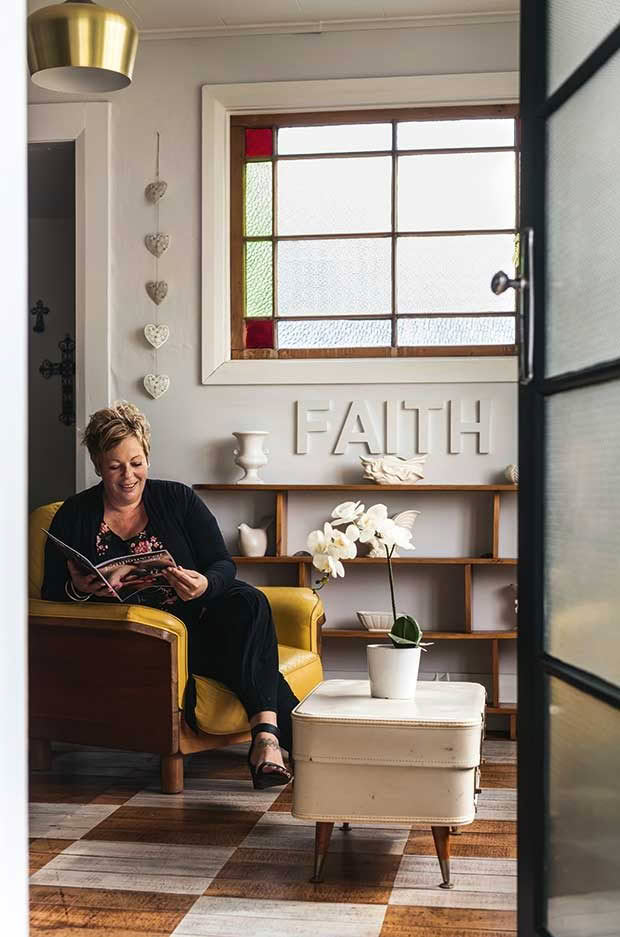
Mel has screwed the legs of a retro liquor cabinet into the bottom of a suitcase to create a quirky coffee table.
Meet Foxton’s upcycling queen. Not only does she create stylish effects with masking tape and bright paint, she also redistributes any profits she earns from her clever crafting.
Words: Lee-Anne Duncan Photos: Mike Heydon
Being in Mel Cowan’s home is a little like being Alice in Wonderland — nothing is quite as it seems.
There’s a tea trolley, but it’s sliced in half and hung on the wall. The occasional table used to accompany people on vacation. A retro pulpit has pride of place in the lounge. A piano has been stripped of its music and given a new vocation as a desk.
“I’m always looking at something and seeing in my mind how else it could look, what else it could be,” Mel says, sitting at the kitchen table where most of her projects take place. She’s scratching with her finger at white paint on the wood, a remnant of her last furniture transformation — the de-keyed piano, as it happens.
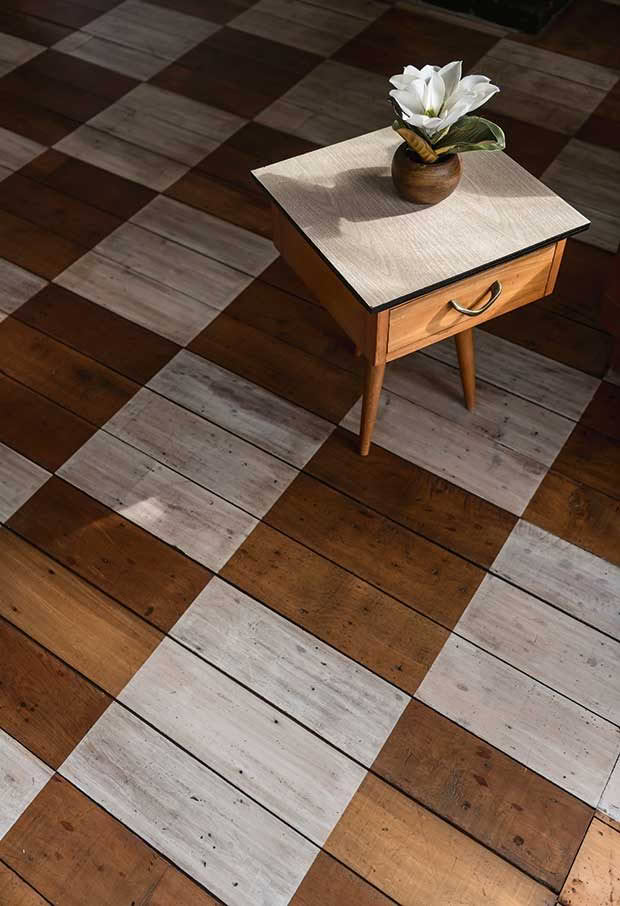
The floor in Mel Cowan’s Foxton home was once covered in lino, which she and husband Steve removed. After a heavy clean-up job, the couple spent ages whitewashing in perfect squares, aided by Mel’s favourite decorating tool — masking tape.
“It’s like a sickness. That’s why I’m continually changing things around here — even if it’s just re-arranging stuff. I’ll sit in the lounge at night, look at a vase and think, ‘You don’t look amazing anymore.’ I stay awake at night thinking about where I can put that vase, or what I can do to make it look beautiful again.
“I don’t know how often I’ve painted these walls. The white has been in here now for two years, and that’s an amazing length of time. I might keep the white. Maybe I’m getting older? Toning down a bit?”
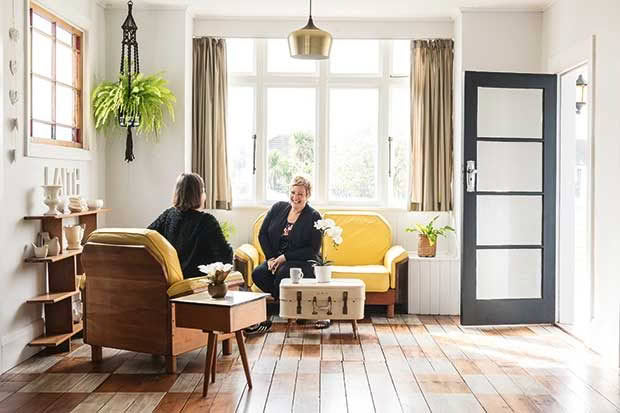
The Cowans bought the house from its original owners 17 years ago and have been improving it ever since. In fact, Mel can’t stop. “I’m always changing things around,” she says. Her friends always notice something new when they visit. The white ceramics (on the storage unit to Mel’s right) were mostly found in second-hand stores, or gifted by Steve’s parents.
Unlikely. It’s hard to imagine Mel getting quieter.
With her six children, six grandchildren, her perpetual projects, her pin-tidy home (despite the children and the projects), her op-shop and church work, she’s quite the force. She and husband Steve got together at 15 and were married by 18. Seventeen years ago, they moved into the Foxton house — it looked a bit different then.
“The kids were all screaming, ‘We’re not moving into that ugly house!’ The same owners had been in here for the past 60 years, and it was all overgrown and in a sad state. Even the real estate agent tried to talk us out of it because of the work, but I could see the potential in it, big time. There was a lot of space, and it had such a nice feeling,” she says.
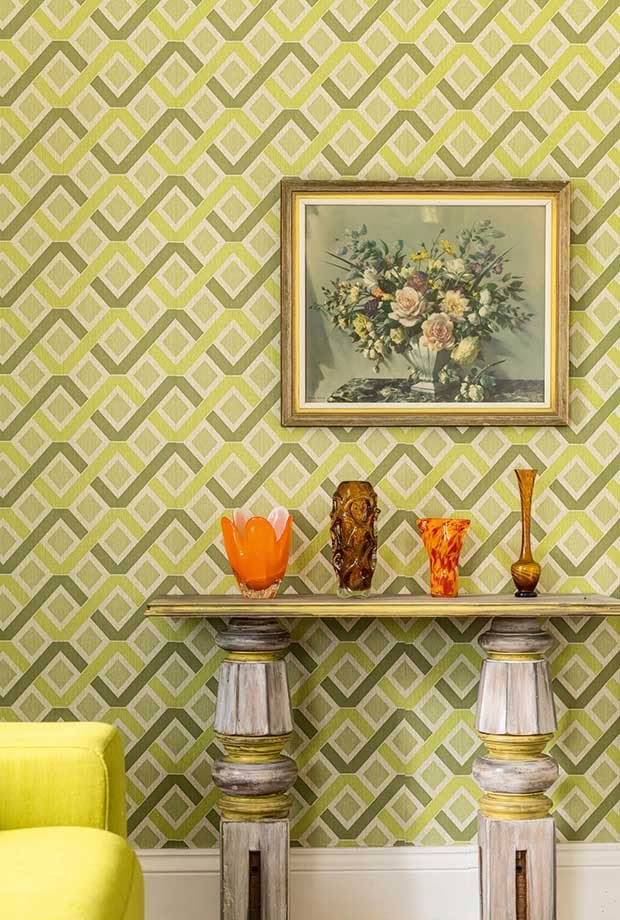
Chunky table legs were screwed into a table extension leaf to become a console table perfect for Mel’s collection of retro glass. The wallpaper is from a second-hand shop, picked up for a mere $3.
The feeling is much nicer now. Mel and Steve had done up their first home, so they knew what needed accomplishing, and knew they would need to do it themselves. The same went for things to put inside the new house.
“For me, having a home like this is a total blessing. Living on one income, with six kids, realistically there’s never been money to have fancy things, or go out and buy a new piece of furniture. If I wanted something to look nice, I was going to have to make it look nice myself. At the same time, when I see something in a shop, I can’t imagine paying someone else for it.”
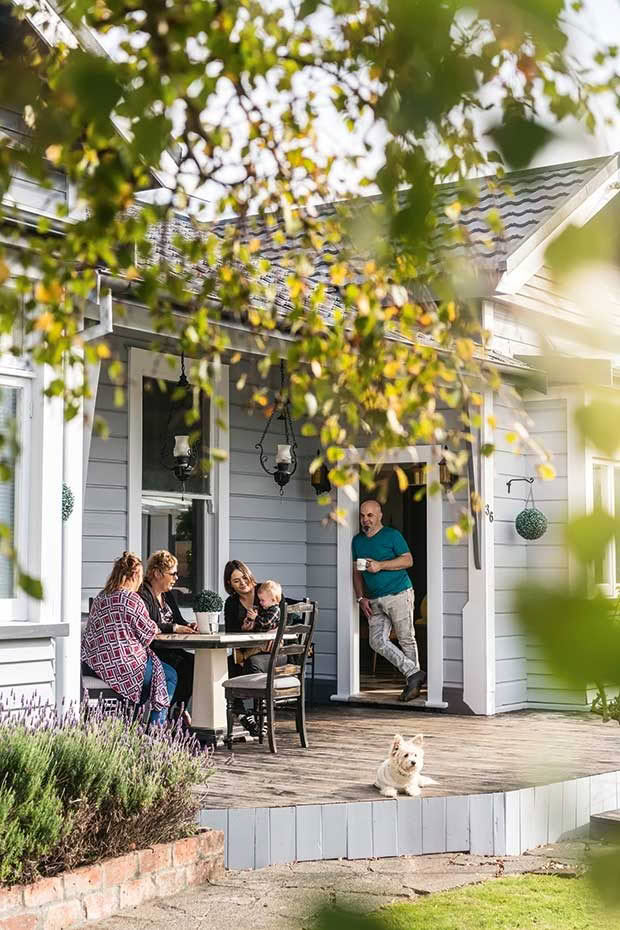
With six kids and six grandkids (all under 10 and nearly all living nearby), Mel and Steve — or Mam and Pap as they’re known — often have a full house.
Mel’s upcycling started in earnest about 10 years ago. There have been so many pieces under her paintbrush since that she can’t possibly recall her first project, but she’s pretty sure where her skills come from.
“My dad was a painter and decorator, so I get the steady hand from him. I’m not one for reading or going on the internet, so I look at something, think about what I want to do, and I work it out. I seem to know how to do it.”
And what she can’t quite manage — “pretty much anything with power tools” — Steve, who works for timber engineer Techlam, steps in, cutting down a headboard, a piano, a tea trolley, adding a lighting fixture or affixing a switch. There’s little wasted; what’s not immediately re-used — the piano’s keys, for example — are kept, ready for future inspirations.
“I’ll use those piano keys for something,” Mel says. Steve’s not always entirely sanguine about Mel’s creative cache in the shed, but he has the equanimity of a long-married man.
So, there’s little in the house with which Mel hasn’t “fiddled”. She looks around, trying to find something. “The leather couches? Maybe? Yeah, not much else.”
There’s a lamp on a side table that looks like it was shop-bought. But, no. “That lamp was a candleholder Steve drilled a hole through and put in the light fitting. And the ball on top was an outside light I found in a junk shop for $3 and thought, ‘I can do something with that,’” she says.

The dining table is where most of Mel’s projects take place — usually when the grandchildren aren’t around. To the right is the piano— Mel (with her husband Steve’s help) sawed it in half, doing away with the innards and turning it into a desk. “I wanted somewhere the kids could sit and do activities,” she says.
Mel’s skills are in demand. However, she says she wouldn’t know where to start to teach others.
“People say, ‘How do you do that?’ And I’m like, ‘Well, how do you use a computer?’ I find this easy — do some sanding and apply some paint — but I have no idea how to use a computer, while others find that so easy. I look at something old, that someone has thrown away, and I can’t wait to transform it. I can see exactly how it should look.”
Not that she gets it right all the time. “I’ve just redone the drawers in our bedroom for the second time. Originally, I did them in different green tones, but immediately I thought it looked too bulky. Maybe I’m a little bit of a perfectionist, but it just didn’t spark joy. It didn’t make me happy. So I had to sand it back and start again. It took only about three and a half hours — I go pretty fast, I don’t muck around.”
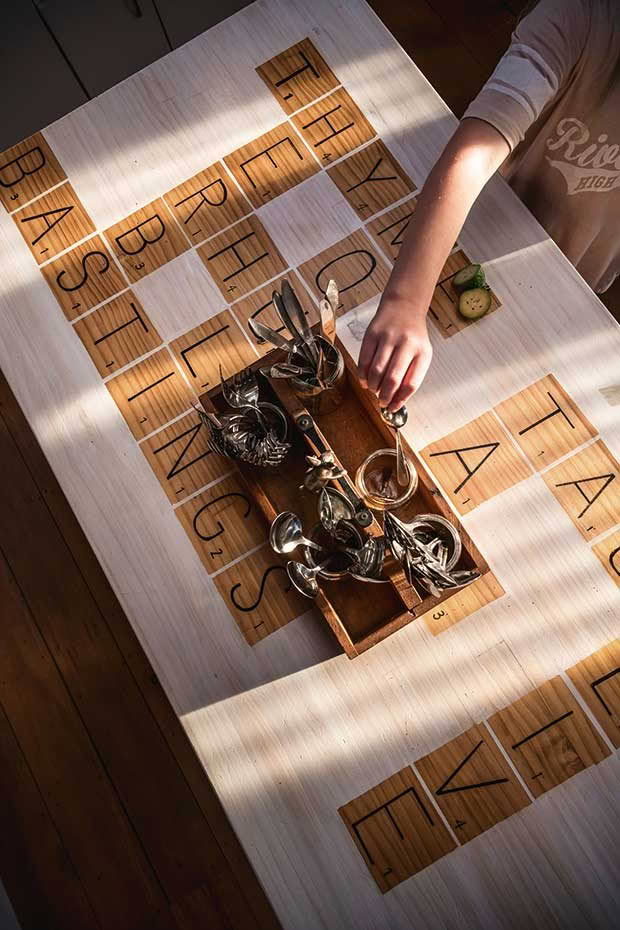
Masking tape turned the kitchen island top into a Scrabble board.
Then, of course, the addition of something new changes how other things looks. “So then I have to change everything else, too. Poor Steve, there’s no such thing as sitting watching a movie at the weekends around here,” she says. Steve shrugs — he
doesn’t mind.
As Mel and Steve’s house has only three bedrooms, not all her projects remain at home. Some are given away, others are sold for a meagre profit. She now sells via her Facebook page, Mel’s Unique Boutique, or the Op Stop, the op-shop she and daughters Kate and Hope run attached to their church in Levin. Or she hangs up a sign on her fence and puts her wares out on the berm, a quick turn off State Highway One at Foxton.
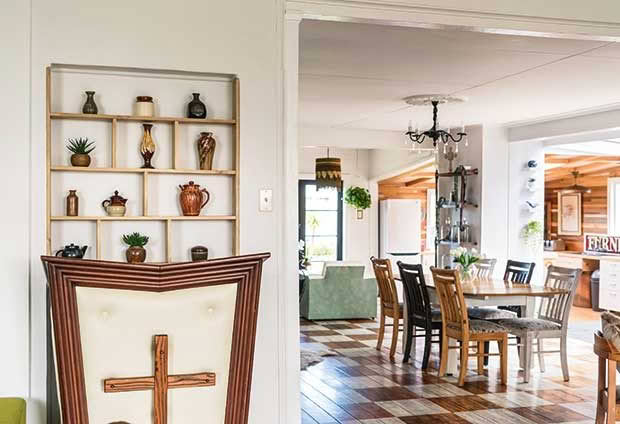
A retro pulpit in the main room. Mel has many possessions but her home is far from cluttered.
“It’s amazing how many people stop. I put a pair of chairs out the other day, and they sold within 15 minutes.”
The price tag is paltry. “It barely covers my costs, certainly not the hours I’ve put in,” says Mel. But whatever she makes is used to buy bags of groceries for families in the community who could do with some support.
“The families have no idea we’re coming [with the groceries], which is nerve-wracking as we’re walking into a place uninvited. There was one lady who was so taken aback she looked quite disturbed, but I went up and cuddled her and she wouldn’t let go. I could do that every day of the week. The joy on some of their faces — they’re overwhelmed by someone’s generosity.”
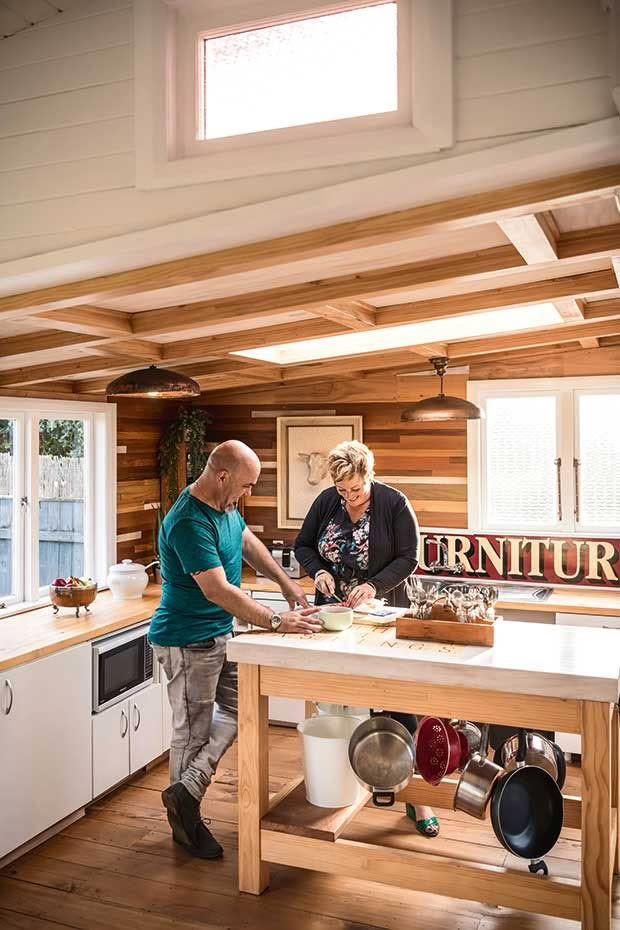
The couple in the kitchen they renovated for $1000. The copper light fittings were once part of their old hot-water cylinder.
People are generous to Mel, too, gifting her pieces so that she can apply her magic to them. Old tables, chairs — even just the legs of tables and chairs — glory boxes that have lost their glory; anything she can sand and paint into new life.
Her floor was perhaps her biggest project. It’s been whitewashed, square by square, in a facsimile of linoleum tiles.
“I wouldn’t do that again,” she says. “The floor had old-fashioned lino on it, which was an awful thing to get rid of. We had to rip it up, then scrape and burn off the tar underneath. That was an ugly job. Then I spent weeks on my knees with a little detail sander. After that, Steve went ahead of me, masking in the squares and I came behind whitewashing. Then we varnished over it.”
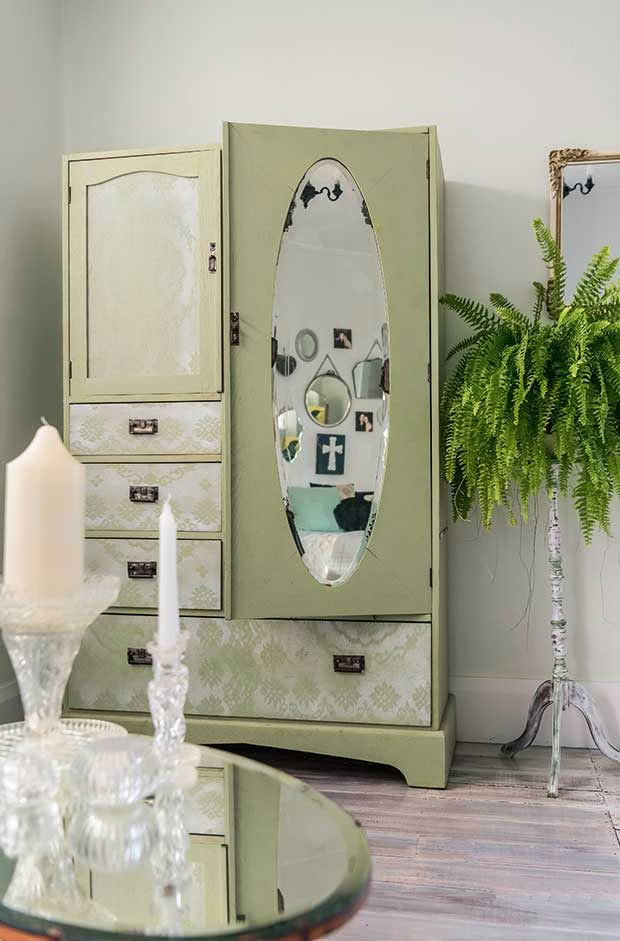
The pattern on Mel’s wardrobe in the couple’s bedroom was created by fixing a lace tablecloth on the drawers and then spray-painting over the cloth before carefully peeling it off. A cheap and effective way of sprucing up furniture, says Mel.
Another ugly job was crafting the beautiful, moss-green tasselled lampshade. “I don’t swear, and making that lampshade made me swear,” she says, with a “never again” glare at the shade.
There’s certainly a lot of whitewash in the Cowan home’s current incarnation. “I love whitewash, and I love that French look. But I like heaps of looks, and I like it jumbled up, all eclectic together. I like every look but cottage. I did like cottage years ago, but I think I overdid it.”
Mel is now being asked by others to decorate their homes. “It’s hard work but the expressions on their faces when they see it finished — they love it, so I just love doing it.”
- Charlotte “aka Barbie Doll”, a corgi/bichon frise, models a jacket from Kmart.
- A dining chair does double-duty as a towel rail and shelf — yet another example of the way domestic items are repurposed in Mel’s Foxton home.
While it means she’s less likely to pick up another paintbrush when she gets home, there’s no way another painter would get near her house.
“I couldn’t even imagine it. The thought of someone else painting my windows? Oh my goodness, no. They might get it on the glass, do a bad job, and I’d have to pay them. No, no.”
MEL’S DECORATING HACKS
It doesn’t take much to breathe new life into an old piece or change its look. Here are some of Mel’s main moves.
♦ Use fabrics to create patterns and texture. “Lie a lace tablecloth on a surface and spray-paint over the top. Carefully peel off the cloth and varnish the wood.” Mel has also sewn doilies onto armchairs.
♦ Use masking tape. Masking tape makes easy work of painting straight lines. “I love the look of natural wood against whitewash,” says Mel. “I like taking off the masking tape and seeing the whole effect coming off clean. You can get a whole new look just with masking tape.”
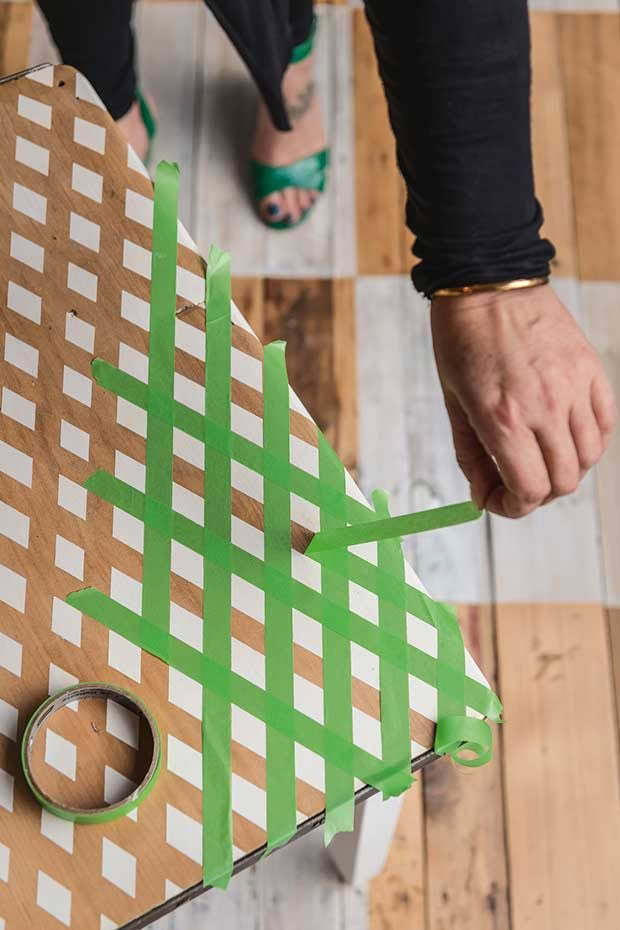
♦ Preserve photos in oil. Mel has a wedding photo in a jar of oil in her bedroom. “It sounds odd, but it stops fading and is more interesting than putting it in a frame.”
♦ Innersprings as photo-holders. Photos can also be fitted into mattress innersprings once the foam has been extracted. (Mel’s mattress has found new life in the garden, with a creeper growing up it.)
♦ Chalk paint. Mel makes chalk paint (which can be used on furniture to create a milky or distressed look) as it’s expensive. Add two teaspoons of tile grout to 500ml of standard acrylic paint. “That works well for me,” she says.
♦ Go green. Mel often uses artificial plants to add green to a room. “I’m not overly great with the real ones. They tend to die on me. And the artificial ones can look so realistic. I get excited when I get a new one.”
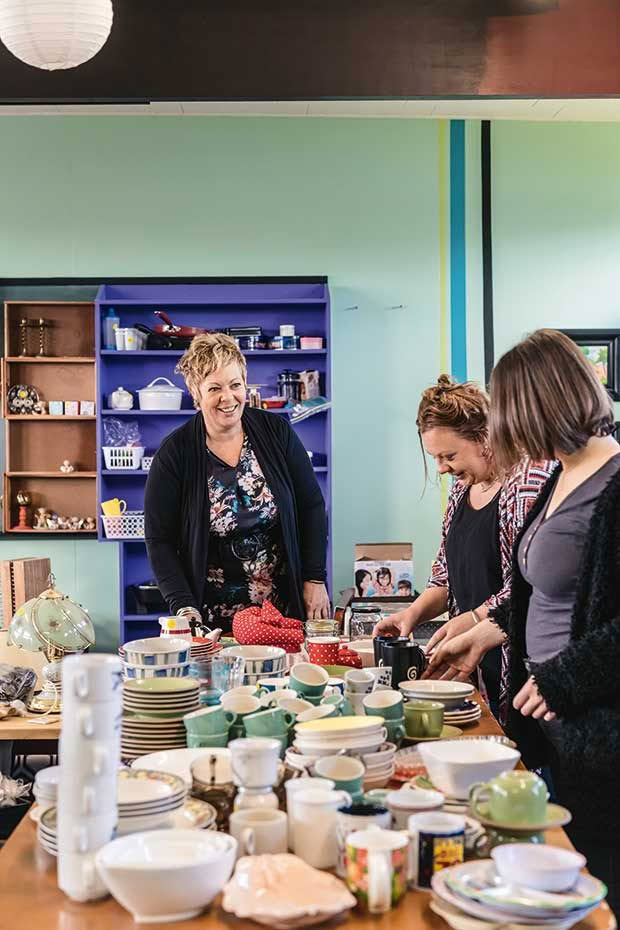
Mel and daughters Kate and Hope in the Op Stop store they run in association with their church in Levin. All profits support the community and go toward buying groceries for people in need.
♦ Think outside the box. Not everything needs “to be attacked with a paint brush — it can be transformed in the way you dress it. Let the imagination run wild.”
MORE HERE:
Japanese Furoshiki: An eco-friendly alternative to paper gift wrapping
Love this story? Subscribe now!
 This article first appeared in NZ Life & Leisure Magazine.
This article first appeared in NZ Life & Leisure Magazine.
